Psychological Perspectives on Violence and Aggression in Young Adults
VerifiedAdded on 2023/06/10
|12
|4089
|382
Essay
AI Summary
This essay critically examines psychological theories explaining violence and aggression in young people, covering biological and social-psychological perspectives. It discusses biological factors like testosterone levels and amygdala function, alongside social learning theory, social cognitive theory, and group processes such as in-group/out-group dynamics. The essay also explores contact theory, realistic conflict theory, and social identity theory, referencing studies like the Robber's Cave experiment. It highlights how aggression can be learned through observation and influenced by environmental factors, including intergenerational transmission and group interactions. While acknowledging the potential for intergroup contact to reduce aggression, the essay also notes circumstances where it can exacerbate negative stereotypes. The analysis integrates various research findings to provide a comprehensive understanding of the psychological factors contributing to youth violence and aggression.
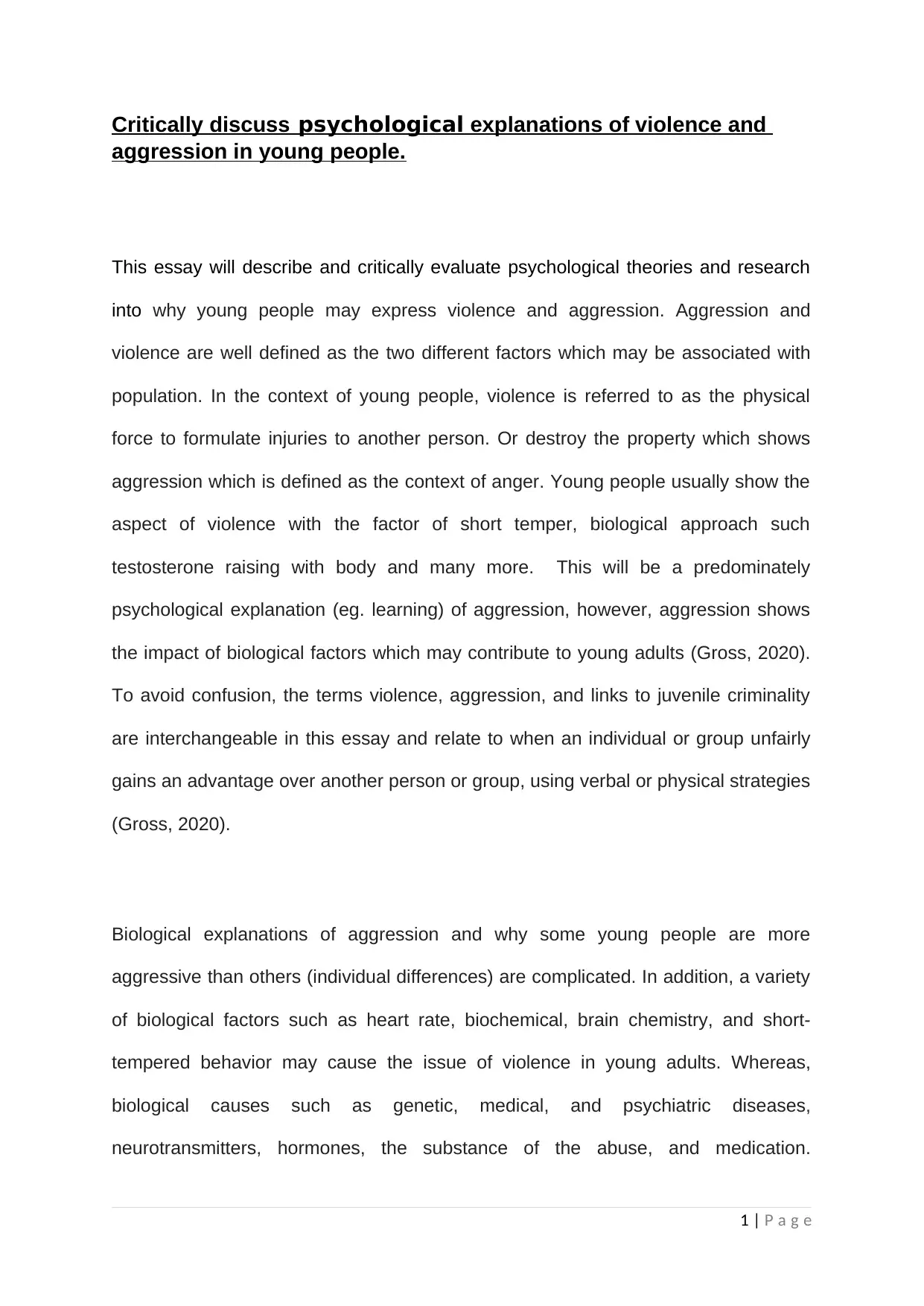
Critically discuss psychological explanations of violence and
aggression in young people.
This essay will describe and critically evaluate psychological theories and research
into why young people may express violence and aggression. Aggression and
violence are well defined as the two different factors which may be associated with
population. In the context of young people, violence is referred to as the physical
force to formulate injuries to another person. Or destroy the property which shows
aggression which is defined as the context of anger. Young people usually show the
aspect of violence with the factor of short temper, biological approach such
testosterone raising with body and many more. This will be a predominately
psychological explanation (eg. learning) of aggression, however, aggression shows
the impact of biological factors which may contribute to young adults (Gross, 2020).
To avoid confusion, the terms violence, aggression, and links to juvenile criminality
are interchangeable in this essay and relate to when an individual or group unfairly
gains an advantage over another person or group, using verbal or physical strategies
(Gross, 2020).
Biological explanations of aggression and why some young people are more
aggressive than others (individual differences) are complicated. In addition, a variety
of biological factors such as heart rate, biochemical, brain chemistry, and short-
tempered behavior may cause the issue of violence in young adults. Whereas,
biological causes such as genetic, medical, and psychiatric diseases,
neurotransmitters, hormones, the substance of the abuse, and medication.
1 | P a g e
aggression in young people.
This essay will describe and critically evaluate psychological theories and research
into why young people may express violence and aggression. Aggression and
violence are well defined as the two different factors which may be associated with
population. In the context of young people, violence is referred to as the physical
force to formulate injuries to another person. Or destroy the property which shows
aggression which is defined as the context of anger. Young people usually show the
aspect of violence with the factor of short temper, biological approach such
testosterone raising with body and many more. This will be a predominately
psychological explanation (eg. learning) of aggression, however, aggression shows
the impact of biological factors which may contribute to young adults (Gross, 2020).
To avoid confusion, the terms violence, aggression, and links to juvenile criminality
are interchangeable in this essay and relate to when an individual or group unfairly
gains an advantage over another person or group, using verbal or physical strategies
(Gross, 2020).
Biological explanations of aggression and why some young people are more
aggressive than others (individual differences) are complicated. In addition, a variety
of biological factors such as heart rate, biochemical, brain chemistry, and short-
tempered behavior may cause the issue of violence in young adults. Whereas,
biological causes such as genetic, medical, and psychiatric diseases,
neurotransmitters, hormones, the substance of the abuse, and medication.
1 | P a g e
Paraphrase This Document
Need a fresh take? Get an instant paraphrase of this document with our AI Paraphraser
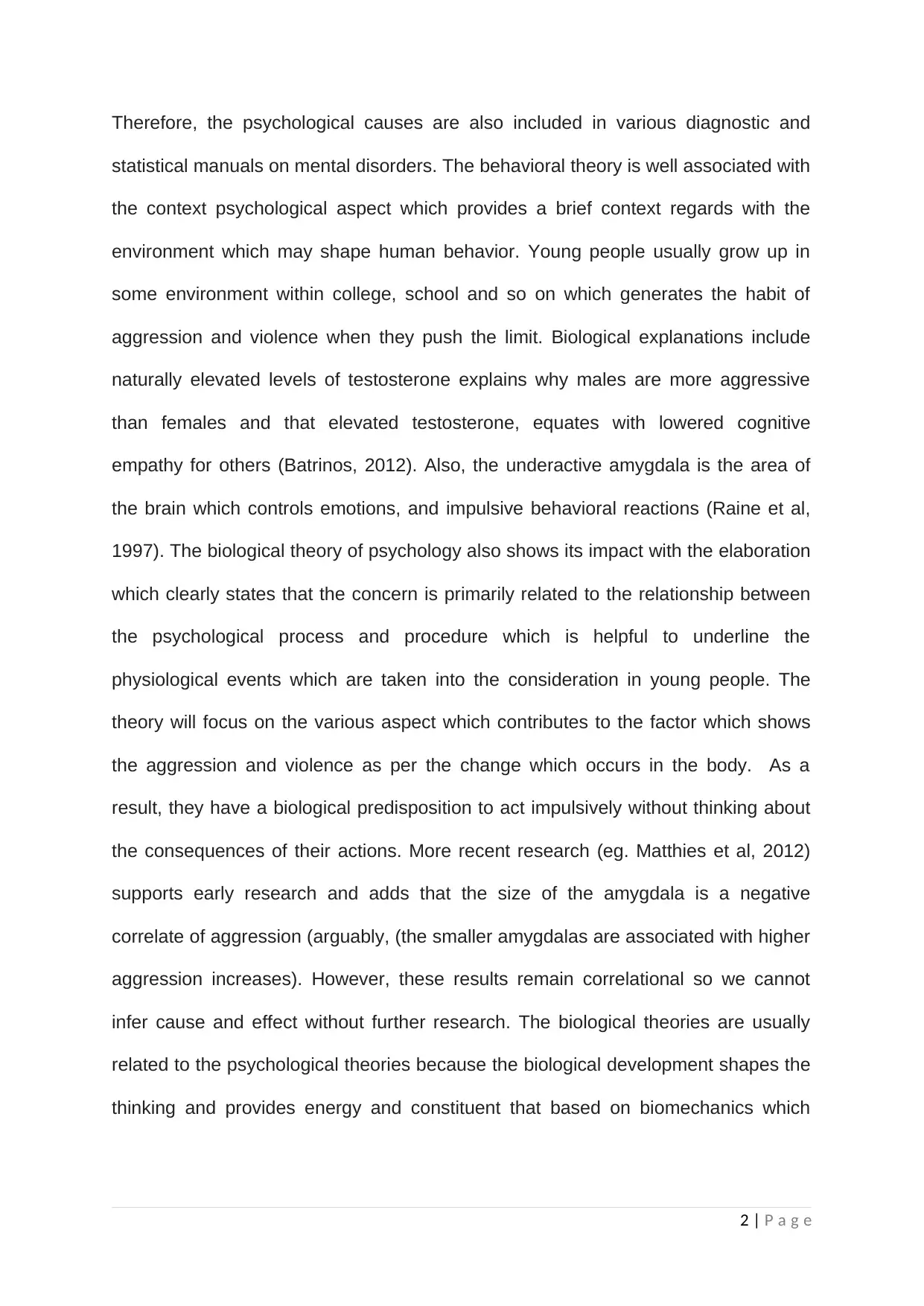
Therefore, the psychological causes are also included in various diagnostic and
statistical manuals on mental disorders. The behavioral theory is well associated with
the context psychological aspect which provides a brief context regards with the
environment which may shape human behavior. Young people usually grow up in
some environment within college, school and so on which generates the habit of
aggression and violence when they push the limit. Biological explanations include
naturally elevated levels of testosterone explains why males are more aggressive
than females and that elevated testosterone, equates with lowered cognitive
empathy for others (Batrinos, 2012). Also, the underactive amygdala is the area of
the brain which controls emotions, and impulsive behavioral reactions (Raine et al,
1997). The biological theory of psychology also shows its impact with the elaboration
which clearly states that the concern is primarily related to the relationship between
the psychological process and procedure which is helpful to underline the
physiological events which are taken into the consideration in young people. The
theory will focus on the various aspect which contributes to the factor which shows
the aggression and violence as per the change which occurs in the body. As a
result, they have a biological predisposition to act impulsively without thinking about
the consequences of their actions. More recent research (eg. Matthies et al, 2012)
supports early research and adds that the size of the amygdala is a negative
correlate of aggression (arguably, (the smaller amygdalas are associated with higher
aggression increases). However, these results remain correlational so we cannot
infer cause and effect without further research. The biological theories are usually
related to the psychological theories because the biological development shapes the
thinking and provides energy and constituent that based on biomechanics which
2 | P a g e
statistical manuals on mental disorders. The behavioral theory is well associated with
the context psychological aspect which provides a brief context regards with the
environment which may shape human behavior. Young people usually grow up in
some environment within college, school and so on which generates the habit of
aggression and violence when they push the limit. Biological explanations include
naturally elevated levels of testosterone explains why males are more aggressive
than females and that elevated testosterone, equates with lowered cognitive
empathy for others (Batrinos, 2012). Also, the underactive amygdala is the area of
the brain which controls emotions, and impulsive behavioral reactions (Raine et al,
1997). The biological theory of psychology also shows its impact with the elaboration
which clearly states that the concern is primarily related to the relationship between
the psychological process and procedure which is helpful to underline the
physiological events which are taken into the consideration in young people. The
theory will focus on the various aspect which contributes to the factor which shows
the aggression and violence as per the change which occurs in the body. As a
result, they have a biological predisposition to act impulsively without thinking about
the consequences of their actions. More recent research (eg. Matthies et al, 2012)
supports early research and adds that the size of the amygdala is a negative
correlate of aggression (arguably, (the smaller amygdalas are associated with higher
aggression increases). However, these results remain correlational so we cannot
infer cause and effect without further research. The biological theories are usually
related to the psychological theories because the biological development shapes the
thinking and provides energy and constituent that based on biomechanics which
2 | P a g e
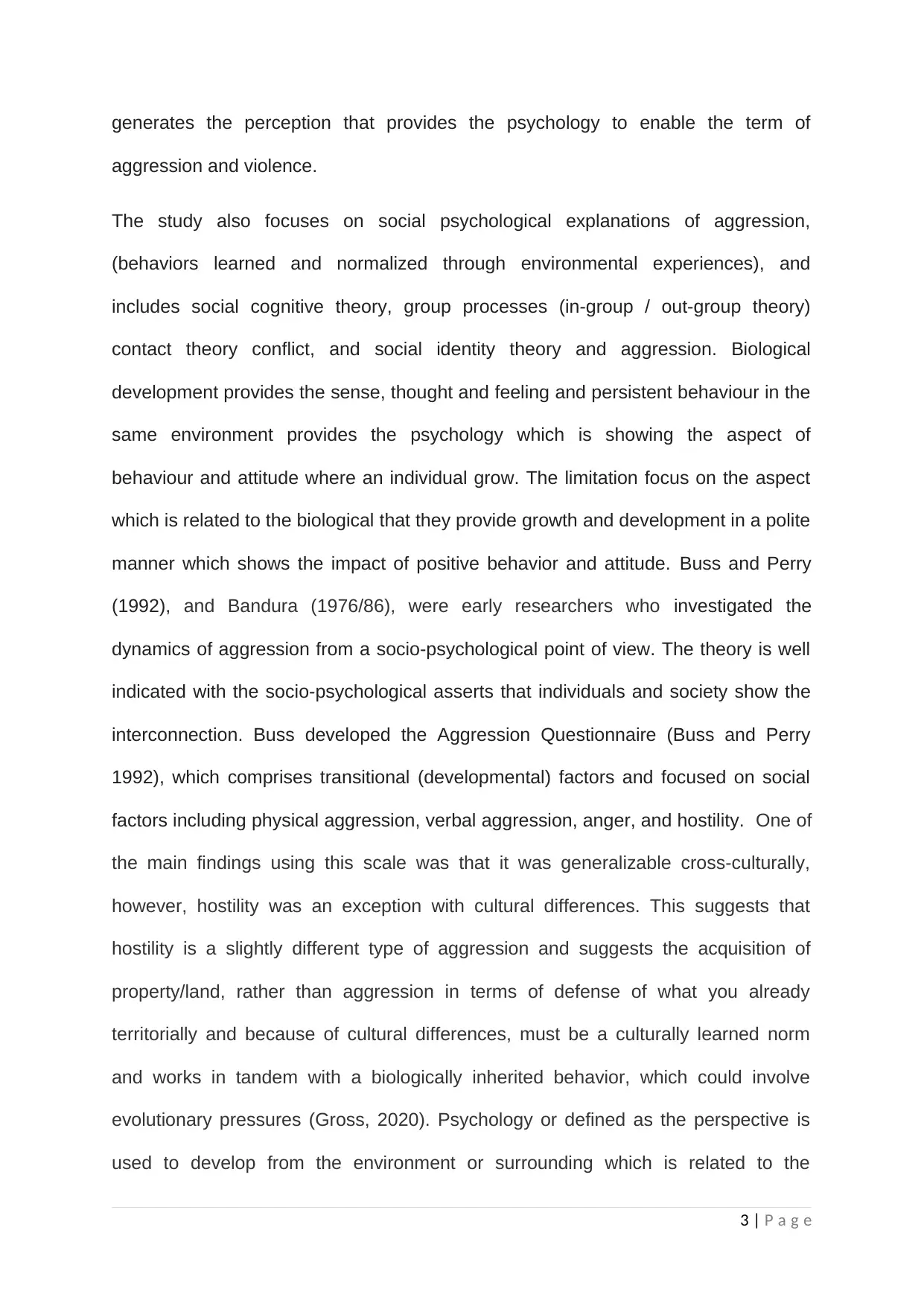
generates the perception that provides the psychology to enable the term of
aggression and violence.
The study also focuses on social psychological explanations of aggression,
(behaviors learned and normalized through environmental experiences), and
includes social cognitive theory, group processes (in-group / out-group theory)
contact theory conflict, and social identity theory and aggression. Biological
development provides the sense, thought and feeling and persistent behaviour in the
same environment provides the psychology which is showing the aspect of
behaviour and attitude where an individual grow. The limitation focus on the aspect
which is related to the biological that they provide growth and development in a polite
manner which shows the impact of positive behavior and attitude. Buss and Perry
(1992), and Bandura (1976/86), were early researchers who investigated the
dynamics of aggression from a socio-psychological point of view. The theory is well
indicated with the socio-psychological asserts that individuals and society show the
interconnection. Buss developed the Aggression Questionnaire (Buss and Perry
1992), which comprises transitional (developmental) factors and focused on social
factors including physical aggression, verbal aggression, anger, and hostility. One of
the main findings using this scale was that it was generalizable cross-culturally,
however, hostility was an exception with cultural differences. This suggests that
hostility is a slightly different type of aggression and suggests the acquisition of
property/land, rather than aggression in terms of defense of what you already
territorially and because of cultural differences, must be a culturally learned norm
and works in tandem with a biologically inherited behavior, which could involve
evolutionary pressures (Gross, 2020). Psychology or defined as the perspective is
used to develop from the environment or surrounding which is related to the
3 | P a g e
aggression and violence.
The study also focuses on social psychological explanations of aggression,
(behaviors learned and normalized through environmental experiences), and
includes social cognitive theory, group processes (in-group / out-group theory)
contact theory conflict, and social identity theory and aggression. Biological
development provides the sense, thought and feeling and persistent behaviour in the
same environment provides the psychology which is showing the aspect of
behaviour and attitude where an individual grow. The limitation focus on the aspect
which is related to the biological that they provide growth and development in a polite
manner which shows the impact of positive behavior and attitude. Buss and Perry
(1992), and Bandura (1976/86), were early researchers who investigated the
dynamics of aggression from a socio-psychological point of view. The theory is well
indicated with the socio-psychological asserts that individuals and society show the
interconnection. Buss developed the Aggression Questionnaire (Buss and Perry
1992), which comprises transitional (developmental) factors and focused on social
factors including physical aggression, verbal aggression, anger, and hostility. One of
the main findings using this scale was that it was generalizable cross-culturally,
however, hostility was an exception with cultural differences. This suggests that
hostility is a slightly different type of aggression and suggests the acquisition of
property/land, rather than aggression in terms of defense of what you already
territorially and because of cultural differences, must be a culturally learned norm
and works in tandem with a biologically inherited behavior, which could involve
evolutionary pressures (Gross, 2020). Psychology or defined as the perspective is
used to develop from the environment or surrounding which is related to the
3 | P a g e
⊘ This is a preview!⊘
Do you want full access?
Subscribe today to unlock all pages.

Trusted by 1+ million students worldwide
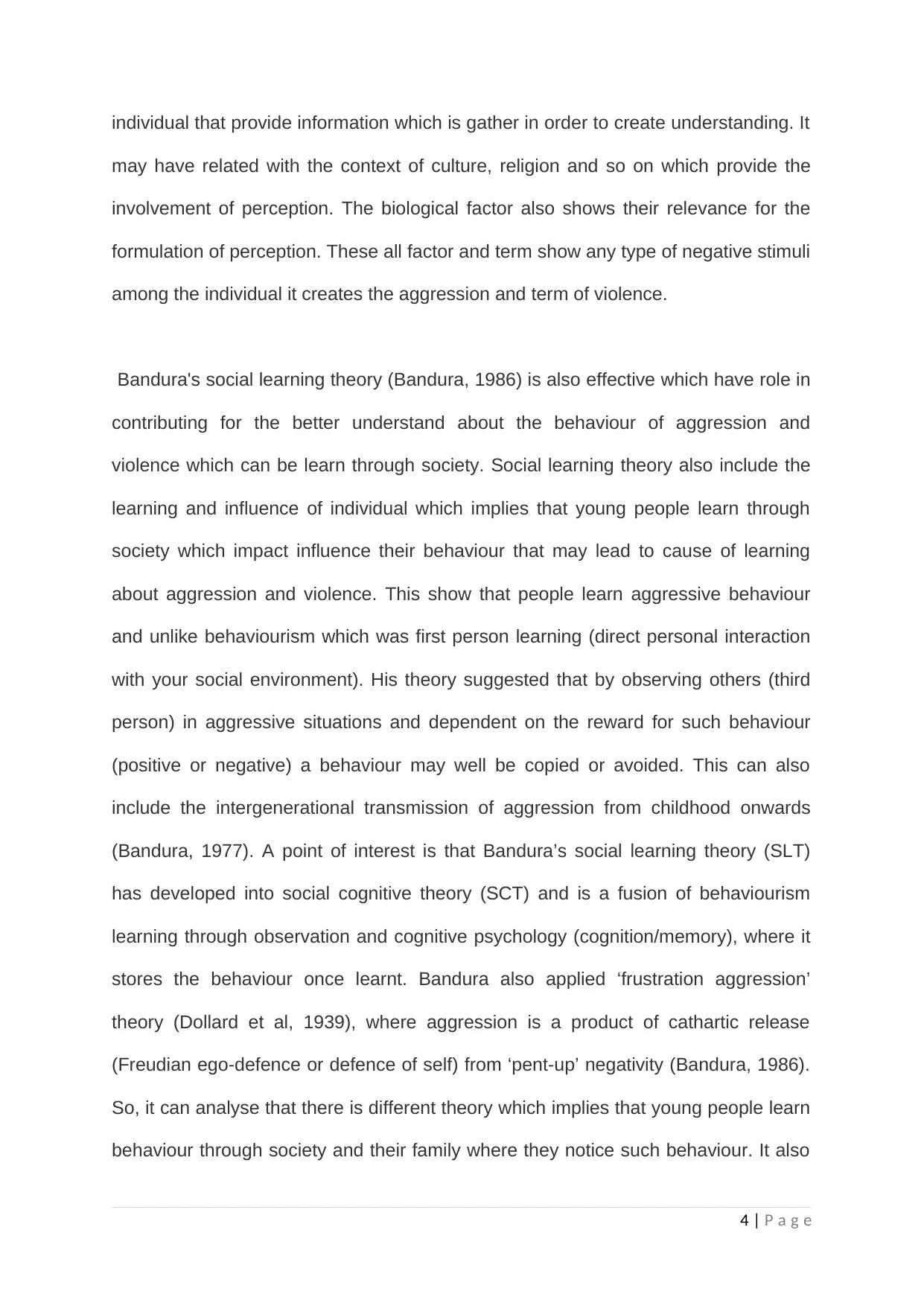
individual that provide information which is gather in order to create understanding. It
may have related with the context of culture, religion and so on which provide the
involvement of perception. The biological factor also shows their relevance for the
formulation of perception. These all factor and term show any type of negative stimuli
among the individual it creates the aggression and term of violence.
Bandura's social learning theory (Bandura, 1986) is also effective which have role in
contributing for the better understand about the behaviour of aggression and
violence which can be learn through society. Social learning theory also include the
learning and influence of individual which implies that young people learn through
society which impact influence their behaviour that may lead to cause of learning
about aggression and violence. This show that people learn aggressive behaviour
and unlike behaviourism which was first person learning (direct personal interaction
with your social environment). His theory suggested that by observing others (third
person) in aggressive situations and dependent on the reward for such behaviour
(positive or negative) a behaviour may well be copied or avoided. This can also
include the intergenerational transmission of aggression from childhood onwards
(Bandura, 1977). A point of interest is that Bandura’s social learning theory (SLT)
has developed into social cognitive theory (SCT) and is a fusion of behaviourism
learning through observation and cognitive psychology (cognition/memory), where it
stores the behaviour once learnt. Bandura also applied ‘frustration aggression’
theory (Dollard et al, 1939), where aggression is a product of cathartic release
(Freudian ego-defence or defence of self) from ‘pent-up’ negativity (Bandura, 1986).
So, it can analyse that there is different theory which implies that young people learn
behaviour through society and their family where they notice such behaviour. It also
4 | P a g e
may have related with the context of culture, religion and so on which provide the
involvement of perception. The biological factor also shows their relevance for the
formulation of perception. These all factor and term show any type of negative stimuli
among the individual it creates the aggression and term of violence.
Bandura's social learning theory (Bandura, 1986) is also effective which have role in
contributing for the better understand about the behaviour of aggression and
violence which can be learn through society. Social learning theory also include the
learning and influence of individual which implies that young people learn through
society which impact influence their behaviour that may lead to cause of learning
about aggression and violence. This show that people learn aggressive behaviour
and unlike behaviourism which was first person learning (direct personal interaction
with your social environment). His theory suggested that by observing others (third
person) in aggressive situations and dependent on the reward for such behaviour
(positive or negative) a behaviour may well be copied or avoided. This can also
include the intergenerational transmission of aggression from childhood onwards
(Bandura, 1977). A point of interest is that Bandura’s social learning theory (SLT)
has developed into social cognitive theory (SCT) and is a fusion of behaviourism
learning through observation and cognitive psychology (cognition/memory), where it
stores the behaviour once learnt. Bandura also applied ‘frustration aggression’
theory (Dollard et al, 1939), where aggression is a product of cathartic release
(Freudian ego-defence or defence of self) from ‘pent-up’ negativity (Bandura, 1986).
So, it can analyse that there is different theory which implies that young people learn
behaviour through society and their family where they notice such behaviour. It also
4 | P a g e
Paraphrase This Document
Need a fresh take? Get an instant paraphrase of this document with our AI Paraphraser
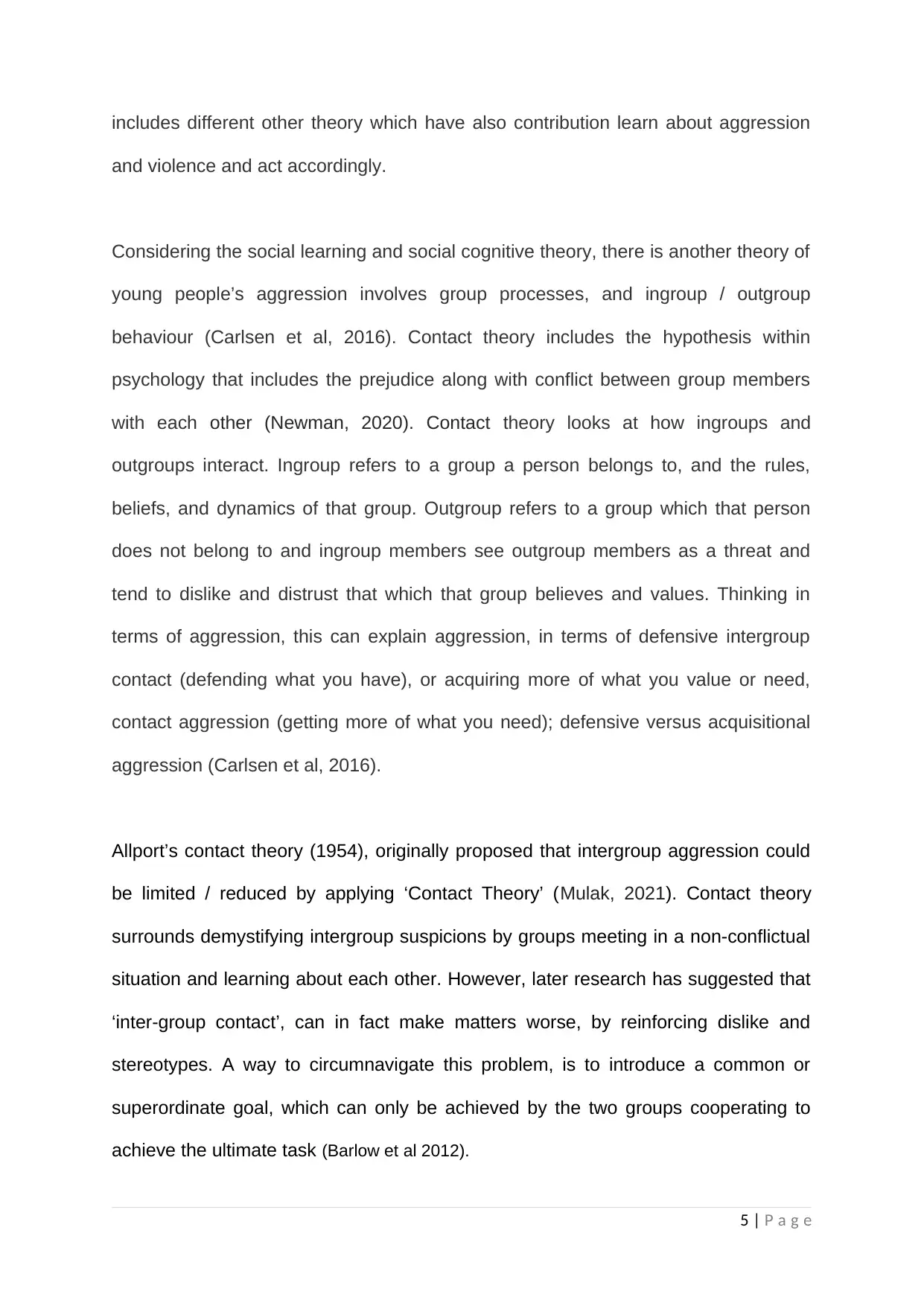
includes different other theory which have also contribution learn about aggression
and violence and act accordingly.
Considering the social learning and social cognitive theory, there is another theory of
young people’s aggression involves group processes, and ingroup / outgroup
behaviour (Carlsen et al, 2016). Contact theory includes the hypothesis within
psychology that includes the prejudice along with conflict between group members
with each other (Newman, 2020). Contact theory looks at how ingroups and
outgroups interact. Ingroup refers to a group a person belongs to, and the rules,
beliefs, and dynamics of that group. Outgroup refers to a group which that person
does not belong to and ingroup members see outgroup members as a threat and
tend to dislike and distrust that which that group believes and values. Thinking in
terms of aggression, this can explain aggression, in terms of defensive intergroup
contact (defending what you have), or acquiring more of what you value or need,
contact aggression (getting more of what you need); defensive versus acquisitional
aggression (Carlsen et al, 2016).
Allport’s contact theory (1954), originally proposed that intergroup aggression could
be limited / reduced by applying ‘Contact Theory’ (Mulak, 2021). Contact theory
surrounds demystifying intergroup suspicions by groups meeting in a non-conflictual
situation and learning about each other. However, later research has suggested that
‘inter-group contact’, can in fact make matters worse, by reinforcing dislike and
stereotypes. A way to circumnavigate this problem, is to introduce a common or
superordinate goal, which can only be achieved by the two groups cooperating to
achieve the ultimate task (Barlow et al 2012).
5 | P a g e
and violence and act accordingly.
Considering the social learning and social cognitive theory, there is another theory of
young people’s aggression involves group processes, and ingroup / outgroup
behaviour (Carlsen et al, 2016). Contact theory includes the hypothesis within
psychology that includes the prejudice along with conflict between group members
with each other (Newman, 2020). Contact theory looks at how ingroups and
outgroups interact. Ingroup refers to a group a person belongs to, and the rules,
beliefs, and dynamics of that group. Outgroup refers to a group which that person
does not belong to and ingroup members see outgroup members as a threat and
tend to dislike and distrust that which that group believes and values. Thinking in
terms of aggression, this can explain aggression, in terms of defensive intergroup
contact (defending what you have), or acquiring more of what you value or need,
contact aggression (getting more of what you need); defensive versus acquisitional
aggression (Carlsen et al, 2016).
Allport’s contact theory (1954), originally proposed that intergroup aggression could
be limited / reduced by applying ‘Contact Theory’ (Mulak, 2021). Contact theory
surrounds demystifying intergroup suspicions by groups meeting in a non-conflictual
situation and learning about each other. However, later research has suggested that
‘inter-group contact’, can in fact make matters worse, by reinforcing dislike and
stereotypes. A way to circumnavigate this problem, is to introduce a common or
superordinate goal, which can only be achieved by the two groups cooperating to
achieve the ultimate task (Barlow et al 2012).
5 | P a g e
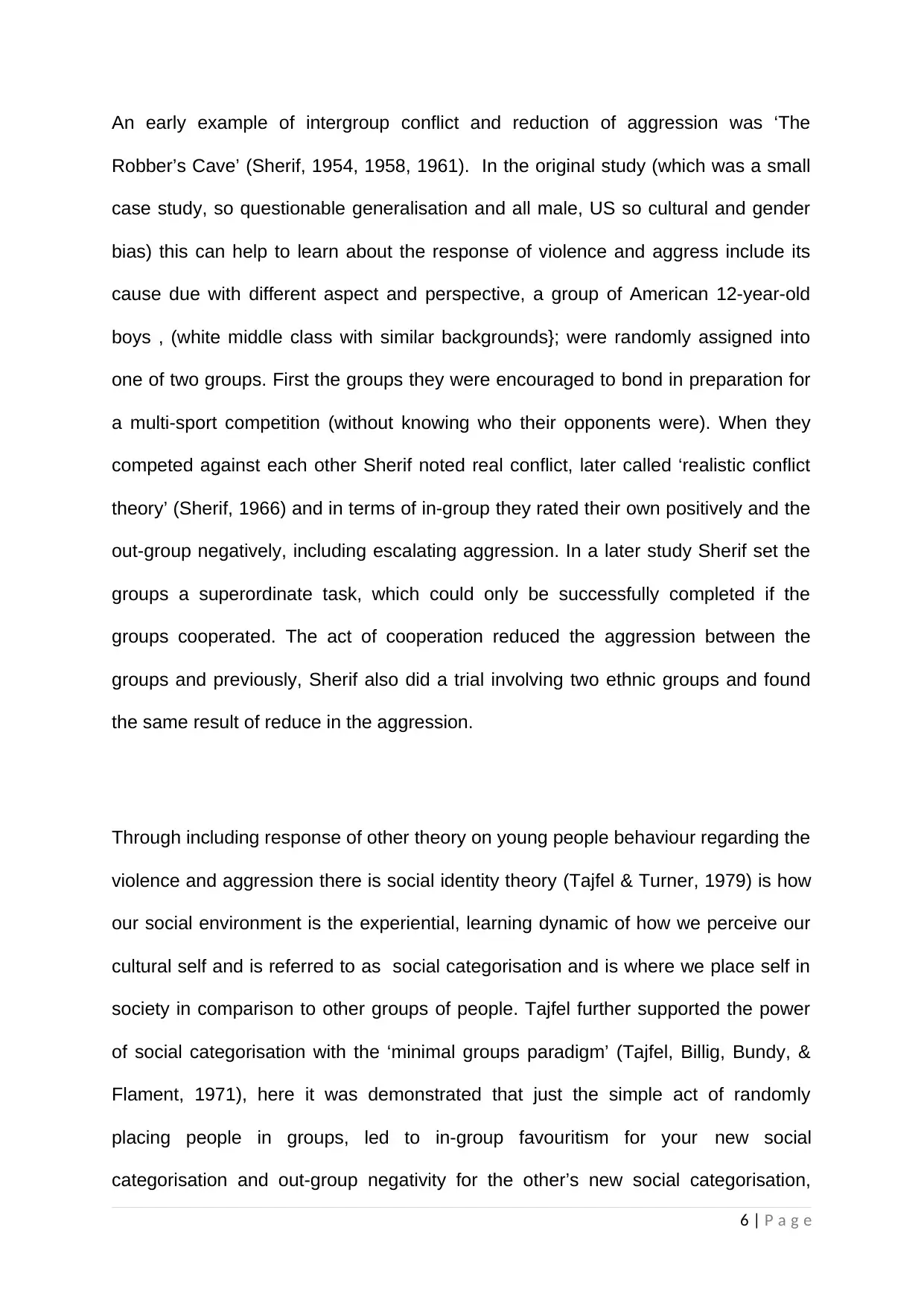
An early example of intergroup conflict and reduction of aggression was ‘The
Robber’s Cave’ (Sherif, 1954, 1958, 1961). In the original study (which was a small
case study, so questionable generalisation and all male, US so cultural and gender
bias) this can help to learn about the response of violence and aggress include its
cause due with different aspect and perspective, a group of American 12-year-old
boys , (white middle class with similar backgrounds}; were randomly assigned into
one of two groups. First the groups they were encouraged to bond in preparation for
a multi-sport competition (without knowing who their opponents were). When they
competed against each other Sherif noted real conflict, later called ‘realistic conflict
theory’ (Sherif, 1966) and in terms of in-group they rated their own positively and the
out-group negatively, including escalating aggression. In a later study Sherif set the
groups a superordinate task, which could only be successfully completed if the
groups cooperated. The act of cooperation reduced the aggression between the
groups and previously, Sherif also did a trial involving two ethnic groups and found
the same result of reduce in the aggression.
Through including response of other theory on young people behaviour regarding the
violence and aggression there is social identity theory (Tajfel & Turner, 1979) is how
our social environment is the experiential, learning dynamic of how we perceive our
cultural self and is referred to as social categorisation and is where we place self in
society in comparison to other groups of people. Tajfel further supported the power
of social categorisation with the ‘minimal groups paradigm’ (Tajfel, Billig, Bundy, &
Flament, 1971), here it was demonstrated that just the simple act of randomly
placing people in groups, led to in-group favouritism for your new social
categorisation and out-group negativity for the other’s new social categorisation,
6 | P a g e
Robber’s Cave’ (Sherif, 1954, 1958, 1961). In the original study (which was a small
case study, so questionable generalisation and all male, US so cultural and gender
bias) this can help to learn about the response of violence and aggress include its
cause due with different aspect and perspective, a group of American 12-year-old
boys , (white middle class with similar backgrounds}; were randomly assigned into
one of two groups. First the groups they were encouraged to bond in preparation for
a multi-sport competition (without knowing who their opponents were). When they
competed against each other Sherif noted real conflict, later called ‘realistic conflict
theory’ (Sherif, 1966) and in terms of in-group they rated their own positively and the
out-group negatively, including escalating aggression. In a later study Sherif set the
groups a superordinate task, which could only be successfully completed if the
groups cooperated. The act of cooperation reduced the aggression between the
groups and previously, Sherif also did a trial involving two ethnic groups and found
the same result of reduce in the aggression.
Through including response of other theory on young people behaviour regarding the
violence and aggression there is social identity theory (Tajfel & Turner, 1979) is how
our social environment is the experiential, learning dynamic of how we perceive our
cultural self and is referred to as social categorisation and is where we place self in
society in comparison to other groups of people. Tajfel further supported the power
of social categorisation with the ‘minimal groups paradigm’ (Tajfel, Billig, Bundy, &
Flament, 1971), here it was demonstrated that just the simple act of randomly
placing people in groups, led to in-group favouritism for your new social
categorisation and out-group negativity for the other’s new social categorisation,
6 | P a g e
⊘ This is a preview!⊘
Do you want full access?
Subscribe today to unlock all pages.

Trusted by 1+ million students worldwide
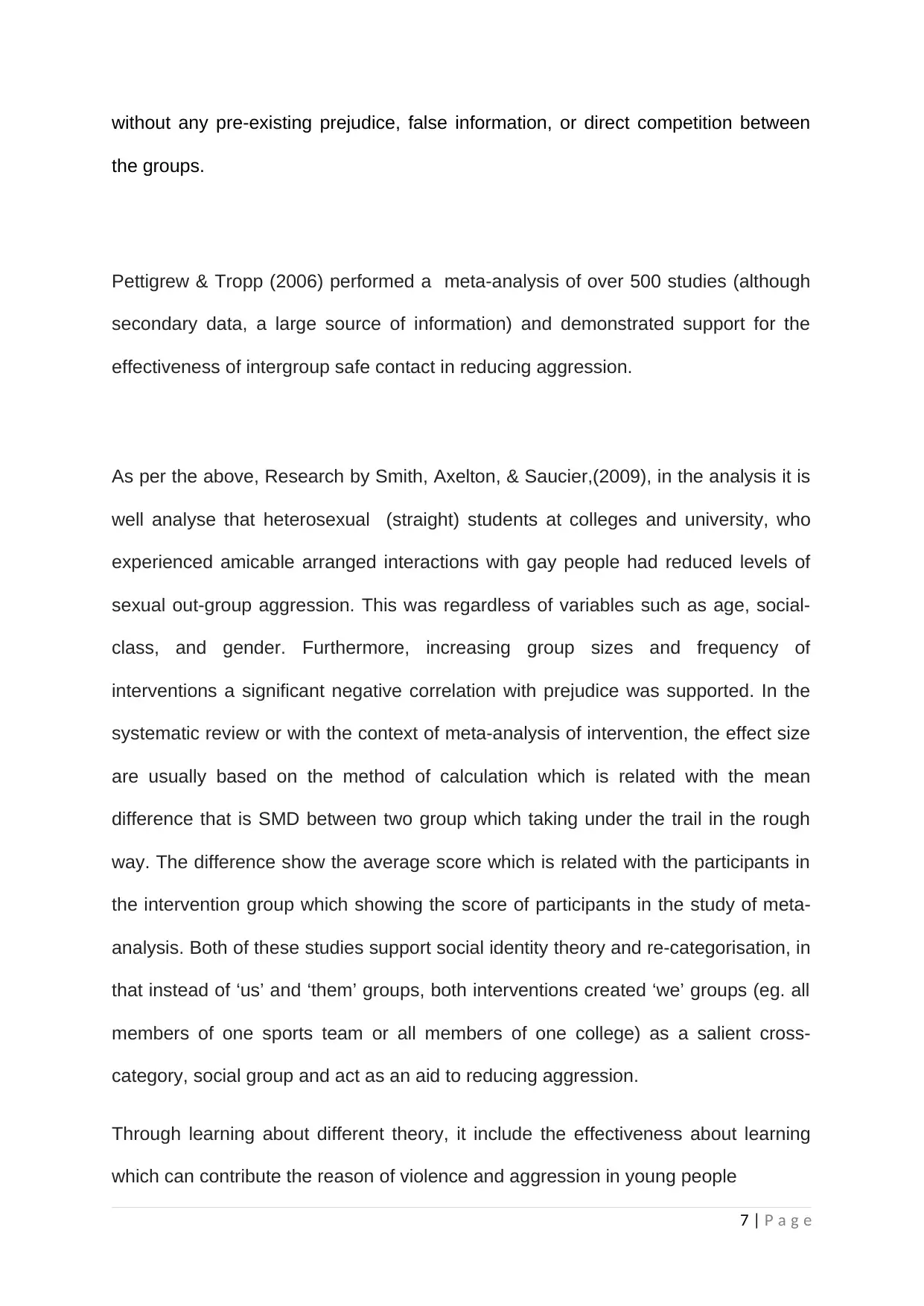
without any pre-existing prejudice, false information, or direct competition between
the groups.
Pettigrew & Tropp (2006) performed a meta-analysis of over 500 studies (although
secondary data, a large source of information) and demonstrated support for the
effectiveness of intergroup safe contact in reducing aggression.
As per the above, Research by Smith, Axelton, & Saucier,(2009), in the analysis it is
well analyse that heterosexual (straight) students at colleges and university, who
experienced amicable arranged interactions with gay people had reduced levels of
sexual out-group aggression. This was regardless of variables such as age, social-
class, and gender. Furthermore, increasing group sizes and frequency of
interventions a significant negative correlation with prejudice was supported. In the
systematic review or with the context of meta-analysis of intervention, the effect size
are usually based on the method of calculation which is related with the mean
difference that is SMD between two group which taking under the trail in the rough
way. The difference show the average score which is related with the participants in
the intervention group which showing the score of participants in the study of meta-
analysis. Both of these studies support social identity theory and re-categorisation, in
that instead of ‘us’ and ‘them’ groups, both interventions created ‘we’ groups (eg. all
members of one sports team or all members of one college) as a salient cross-
category, social group and act as an aid to reducing aggression.
Through learning about different theory, it include the effectiveness about learning
which can contribute the reason of violence and aggression in young people
7 | P a g e
the groups.
Pettigrew & Tropp (2006) performed a meta-analysis of over 500 studies (although
secondary data, a large source of information) and demonstrated support for the
effectiveness of intergroup safe contact in reducing aggression.
As per the above, Research by Smith, Axelton, & Saucier,(2009), in the analysis it is
well analyse that heterosexual (straight) students at colleges and university, who
experienced amicable arranged interactions with gay people had reduced levels of
sexual out-group aggression. This was regardless of variables such as age, social-
class, and gender. Furthermore, increasing group sizes and frequency of
interventions a significant negative correlation with prejudice was supported. In the
systematic review or with the context of meta-analysis of intervention, the effect size
are usually based on the method of calculation which is related with the mean
difference that is SMD between two group which taking under the trail in the rough
way. The difference show the average score which is related with the participants in
the intervention group which showing the score of participants in the study of meta-
analysis. Both of these studies support social identity theory and re-categorisation, in
that instead of ‘us’ and ‘them’ groups, both interventions created ‘we’ groups (eg. all
members of one sports team or all members of one college) as a salient cross-
category, social group and act as an aid to reducing aggression.
Through learning about different theory, it include the effectiveness about learning
which can contribute the reason of violence and aggression in young people
7 | P a g e
Paraphrase This Document
Need a fresh take? Get an instant paraphrase of this document with our AI Paraphraser
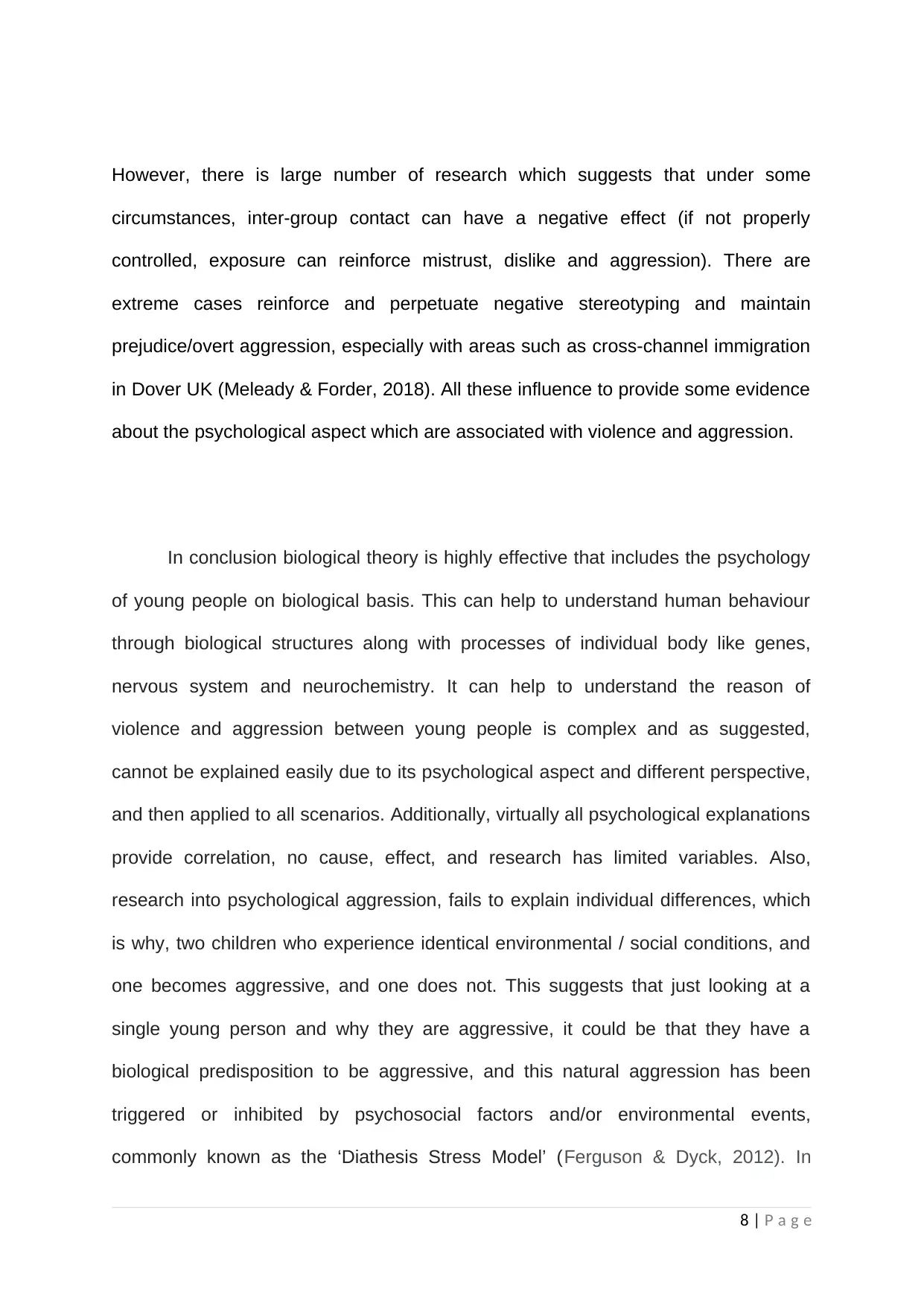
However, there is large number of research which suggests that under some
circumstances, inter-group contact can have a negative effect (if not properly
controlled, exposure can reinforce mistrust, dislike and aggression). There are
extreme cases reinforce and perpetuate negative stereotyping and maintain
prejudice/overt aggression, especially with areas such as cross-channel immigration
in Dover UK (Meleady & Forder, 2018). All these influence to provide some evidence
about the psychological aspect which are associated with violence and aggression.
In conclusion biological theory is highly effective that includes the psychology
of young people on biological basis. This can help to understand human behaviour
through biological structures along with processes of individual body like genes,
nervous system and neurochemistry. It can help to understand the reason of
violence and aggression between young people is complex and as suggested,
cannot be explained easily due to its psychological aspect and different perspective,
and then applied to all scenarios. Additionally, virtually all psychological explanations
provide correlation, no cause, effect, and research has limited variables. Also,
research into psychological aggression, fails to explain individual differences, which
is why, two children who experience identical environmental / social conditions, and
one becomes aggressive, and one does not. This suggests that just looking at a
single young person and why they are aggressive, it could be that they have a
biological predisposition to be aggressive, and this natural aggression has been
triggered or inhibited by psychosocial factors and/or environmental events,
commonly known as the ‘Diathesis Stress Model’ (Ferguson & Dyck, 2012). In
8 | P a g e
circumstances, inter-group contact can have a negative effect (if not properly
controlled, exposure can reinforce mistrust, dislike and aggression). There are
extreme cases reinforce and perpetuate negative stereotyping and maintain
prejudice/overt aggression, especially with areas such as cross-channel immigration
in Dover UK (Meleady & Forder, 2018). All these influence to provide some evidence
about the psychological aspect which are associated with violence and aggression.
In conclusion biological theory is highly effective that includes the psychology
of young people on biological basis. This can help to understand human behaviour
through biological structures along with processes of individual body like genes,
nervous system and neurochemistry. It can help to understand the reason of
violence and aggression between young people is complex and as suggested,
cannot be explained easily due to its psychological aspect and different perspective,
and then applied to all scenarios. Additionally, virtually all psychological explanations
provide correlation, no cause, effect, and research has limited variables. Also,
research into psychological aggression, fails to explain individual differences, which
is why, two children who experience identical environmental / social conditions, and
one becomes aggressive, and one does not. This suggests that just looking at a
single young person and why they are aggressive, it could be that they have a
biological predisposition to be aggressive, and this natural aggression has been
triggered or inhibited by psychosocial factors and/or environmental events,
commonly known as the ‘Diathesis Stress Model’ (Ferguson & Dyck, 2012). In
8 | P a g e
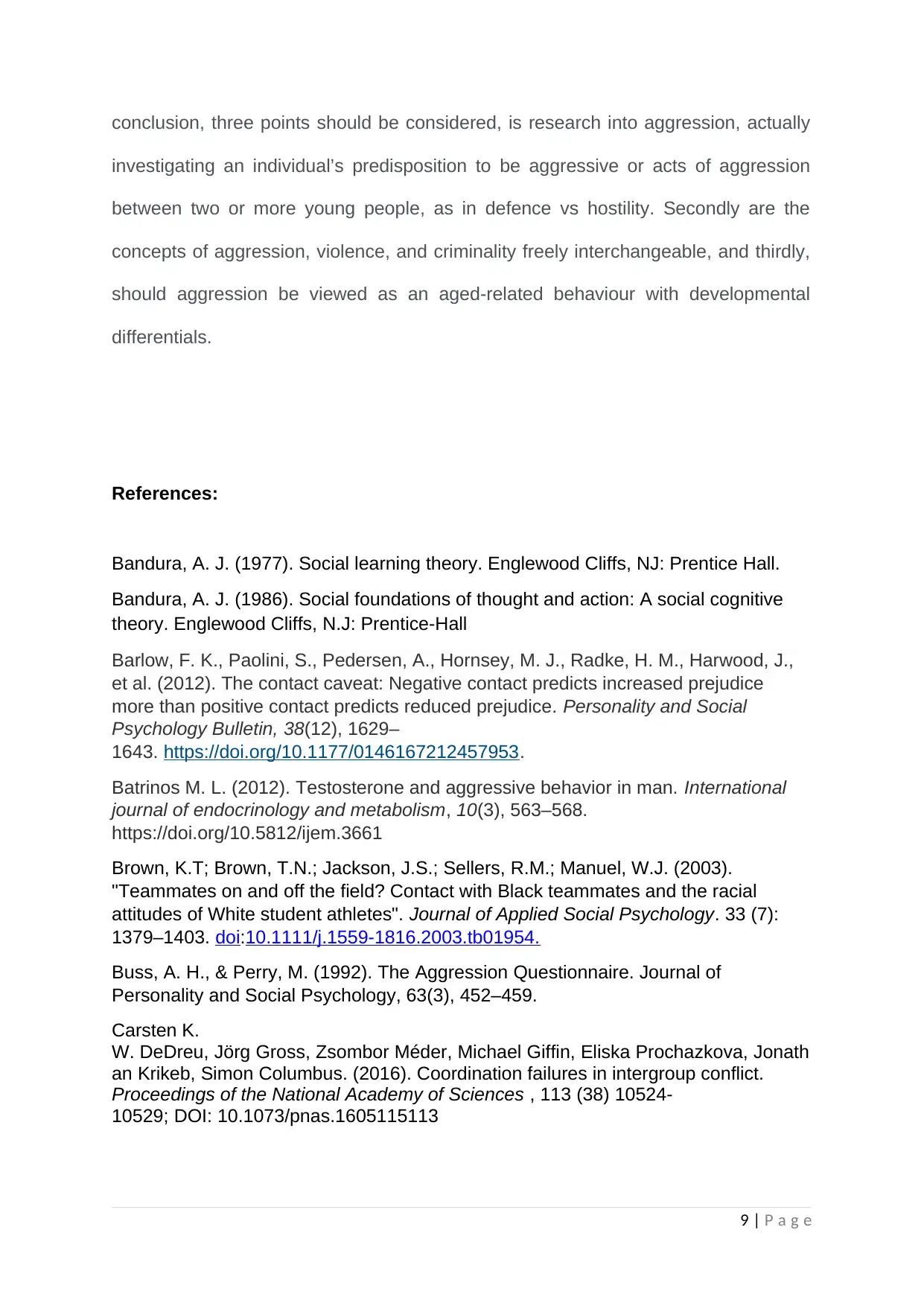
conclusion, three points should be considered, is research into aggression, actually
investigating an individual’s predisposition to be aggressive or acts of aggression
between two or more young people, as in defence vs hostility. Secondly are the
concepts of aggression, violence, and criminality freely interchangeable, and thirdly,
should aggression be viewed as an aged-related behaviour with developmental
differentials.
References:
Bandura, A. J. (1977). Social learning theory. Englewood Cliffs, NJ: Prentice Hall.
Bandura, A. J. (1986). Social foundations of thought and action: A social cognitive
theory. Englewood Cliffs, N.J: Prentice-Hall
Barlow, F. K., Paolini, S., Pedersen, A., Hornsey, M. J., Radke, H. M., Harwood, J.,
et al. (2012). The contact caveat: Negative contact predicts increased prejudice
more than positive contact predicts reduced prejudice. Personality and Social
Psychology Bulletin, 38(12), 1629–
1643. https://doi.org/10.1177/0146167212457953.
Batrinos M. L. (2012). Testosterone and aggressive behavior in man. International
journal of endocrinology and metabolism, 10(3), 563–568.
https://doi.org/10.5812/ijem.3661
Brown, K.T; Brown, T.N.; Jackson, J.S.; Sellers, R.M.; Manuel, W.J. (2003).
"Teammates on and off the field? Contact with Black teammates and the racial
attitudes of White student athletes". Journal of Applied Social Psychology. 33 (7):
1379–1403. doi:10.1111/j.1559-1816.2003.tb01954.
Buss, A. H., & Perry, M. (1992). The Aggression Questionnaire. Journal of
Personality and Social Psychology, 63(3), 452–459.
Carsten K.
W. DeDreu, Jörg Gross, Zsombor Méder, Michael Giffin, Eliska Prochazkova, Jonath
an Krikeb, Simon Columbus. (2016). Coordination failures in intergroup conflict.
Proceedings of the National Academy of Sciences , 113 (38) 10524-
10529; DOI: 10.1073/pnas.1605115113
9 | P a g e
investigating an individual’s predisposition to be aggressive or acts of aggression
between two or more young people, as in defence vs hostility. Secondly are the
concepts of aggression, violence, and criminality freely interchangeable, and thirdly,
should aggression be viewed as an aged-related behaviour with developmental
differentials.
References:
Bandura, A. J. (1977). Social learning theory. Englewood Cliffs, NJ: Prentice Hall.
Bandura, A. J. (1986). Social foundations of thought and action: A social cognitive
theory. Englewood Cliffs, N.J: Prentice-Hall
Barlow, F. K., Paolini, S., Pedersen, A., Hornsey, M. J., Radke, H. M., Harwood, J.,
et al. (2012). The contact caveat: Negative contact predicts increased prejudice
more than positive contact predicts reduced prejudice. Personality and Social
Psychology Bulletin, 38(12), 1629–
1643. https://doi.org/10.1177/0146167212457953.
Batrinos M. L. (2012). Testosterone and aggressive behavior in man. International
journal of endocrinology and metabolism, 10(3), 563–568.
https://doi.org/10.5812/ijem.3661
Brown, K.T; Brown, T.N.; Jackson, J.S.; Sellers, R.M.; Manuel, W.J. (2003).
"Teammates on and off the field? Contact with Black teammates and the racial
attitudes of White student athletes". Journal of Applied Social Psychology. 33 (7):
1379–1403. doi:10.1111/j.1559-1816.2003.tb01954.
Buss, A. H., & Perry, M. (1992). The Aggression Questionnaire. Journal of
Personality and Social Psychology, 63(3), 452–459.
Carsten K.
W. DeDreu, Jörg Gross, Zsombor Méder, Michael Giffin, Eliska Prochazkova, Jonath
an Krikeb, Simon Columbus. (2016). Coordination failures in intergroup conflict.
Proceedings of the National Academy of Sciences , 113 (38) 10524-
10529; DOI: 10.1073/pnas.1605115113
9 | P a g e
⊘ This is a preview!⊘
Do you want full access?
Subscribe today to unlock all pages.

Trusted by 1+ million students worldwide
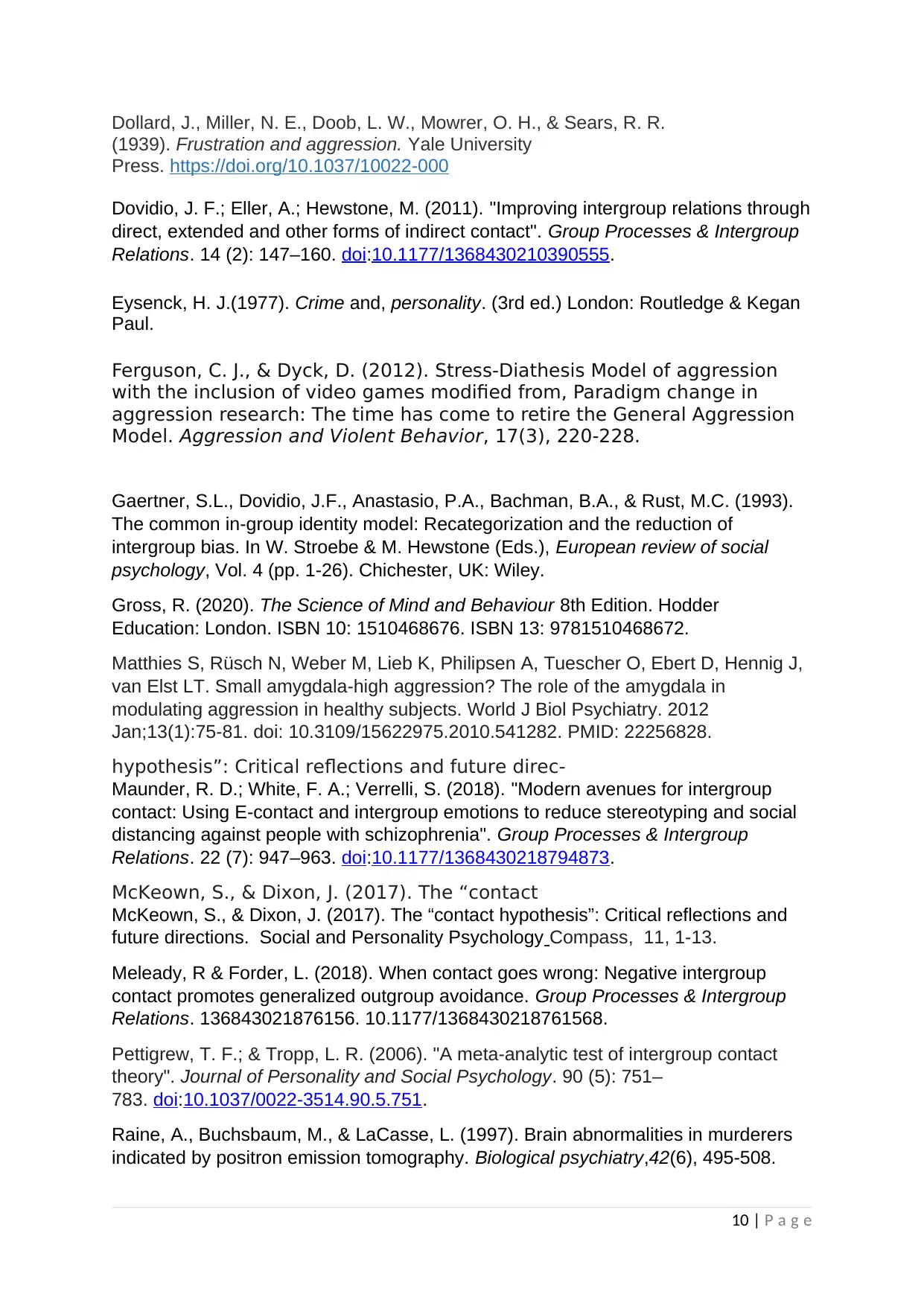
Dollard, J., Miller, N. E., Doob, L. W., Mowrer, O. H., & Sears, R. R.
(1939). Frustration and aggression. Yale University
Press. https://doi.org/10.1037/10022-000
Dovidio, J. F.; Eller, A.; Hewstone, M. (2011). "Improving intergroup relations through
direct, extended and other forms of indirect contact". Group Processes & Intergroup
Relations. 14 (2): 147–160. doi:10.1177/1368430210390555.
Eysenck, H. J.(1977). Crime and, personality. (3rd ed.) London: Routledge & Kegan
Paul.
Ferguson, C. J., & Dyck, D. (2012). Stress-Diathesis Model of aggression
with the inclusion of video games modified from, Paradigm change in
aggression research: The time has come to retire the General Aggression
Model. Aggression and Violent Behavior, 17(3), 220-228.
Gaertner, S.L., Dovidio, J.F., Anastasio, P.A., Bachman, B.A., & Rust, M.C. (1993).
The common in-group identity model: Recategorization and the reduction of
intergroup bias. In W. Stroebe & M. Hewstone (Eds.), European review of social
psychology, Vol. 4 (pp. 1-26). Chichester, UK: Wiley.
Gross, R. (2020). The Science of Mind and Behaviour 8th Edition. Hodder
Education: London. ISBN 10: 1510468676. ISBN 13: 9781510468672.
Matthies S, Rüsch N, Weber M, Lieb K, Philipsen A, Tuescher O, Ebert D, Hennig J,
van Elst LT. Small amygdala-high aggression? The role of the amygdala in
modulating aggression in healthy subjects. World J Biol Psychiatry. 2012
Jan;13(1):75-81. doi: 10.3109/15622975.2010.541282. PMID: 22256828.
hypothesis”: Critical reflections and future direc-
Maunder, R. D.; White, F. A.; Verrelli, S. (2018). "Modern avenues for intergroup
contact: Using E-contact and intergroup emotions to reduce stereotyping and social
distancing against people with schizophrenia". Group Processes & Intergroup
Relations. 22 (7): 947–963. doi:10.1177/1368430218794873.
McKeown, S., & Dixon, J. (2017). The “contact
McKeown, S., & Dixon, J. (2017). The “contact hypothesis”: Critical reflections and
future directions. Social and Personality Psychology Compass, 11, 1-13.
Meleady, R & Forder, L. (2018). When contact goes wrong: Negative intergroup
contact promotes generalized outgroup avoidance. Group Processes & Intergroup
Relations. 136843021876156. 10.1177/1368430218761568.
Pettigrew, T. F.; & Tropp, L. R. (2006). "A meta-analytic test of intergroup contact
theory". Journal of Personality and Social Psychology. 90 (5): 751–
783. doi:10.1037/0022-3514.90.5.751.
Raine, A., Buchsbaum, M., & LaCasse, L. (1997). Brain abnormalities in murderers
indicated by positron emission tomography. Biological psychiatry,42(6), 495-508.
10 | P a g e
(1939). Frustration and aggression. Yale University
Press. https://doi.org/10.1037/10022-000
Dovidio, J. F.; Eller, A.; Hewstone, M. (2011). "Improving intergroup relations through
direct, extended and other forms of indirect contact". Group Processes & Intergroup
Relations. 14 (2): 147–160. doi:10.1177/1368430210390555.
Eysenck, H. J.(1977). Crime and, personality. (3rd ed.) London: Routledge & Kegan
Paul.
Ferguson, C. J., & Dyck, D. (2012). Stress-Diathesis Model of aggression
with the inclusion of video games modified from, Paradigm change in
aggression research: The time has come to retire the General Aggression
Model. Aggression and Violent Behavior, 17(3), 220-228.
Gaertner, S.L., Dovidio, J.F., Anastasio, P.A., Bachman, B.A., & Rust, M.C. (1993).
The common in-group identity model: Recategorization and the reduction of
intergroup bias. In W. Stroebe & M. Hewstone (Eds.), European review of social
psychology, Vol. 4 (pp. 1-26). Chichester, UK: Wiley.
Gross, R. (2020). The Science of Mind and Behaviour 8th Edition. Hodder
Education: London. ISBN 10: 1510468676. ISBN 13: 9781510468672.
Matthies S, Rüsch N, Weber M, Lieb K, Philipsen A, Tuescher O, Ebert D, Hennig J,
van Elst LT. Small amygdala-high aggression? The role of the amygdala in
modulating aggression in healthy subjects. World J Biol Psychiatry. 2012
Jan;13(1):75-81. doi: 10.3109/15622975.2010.541282. PMID: 22256828.
hypothesis”: Critical reflections and future direc-
Maunder, R. D.; White, F. A.; Verrelli, S. (2018). "Modern avenues for intergroup
contact: Using E-contact and intergroup emotions to reduce stereotyping and social
distancing against people with schizophrenia". Group Processes & Intergroup
Relations. 22 (7): 947–963. doi:10.1177/1368430218794873.
McKeown, S., & Dixon, J. (2017). The “contact
McKeown, S., & Dixon, J. (2017). The “contact hypothesis”: Critical reflections and
future directions. Social and Personality Psychology Compass, 11, 1-13.
Meleady, R & Forder, L. (2018). When contact goes wrong: Negative intergroup
contact promotes generalized outgroup avoidance. Group Processes & Intergroup
Relations. 136843021876156. 10.1177/1368430218761568.
Pettigrew, T. F.; & Tropp, L. R. (2006). "A meta-analytic test of intergroup contact
theory". Journal of Personality and Social Psychology. 90 (5): 751–
783. doi:10.1037/0022-3514.90.5.751.
Raine, A., Buchsbaum, M., & LaCasse, L. (1997). Brain abnormalities in murderers
indicated by positron emission tomography. Biological psychiatry,42(6), 495-508.
10 | P a g e
Paraphrase This Document
Need a fresh take? Get an instant paraphrase of this document with our AI Paraphraser
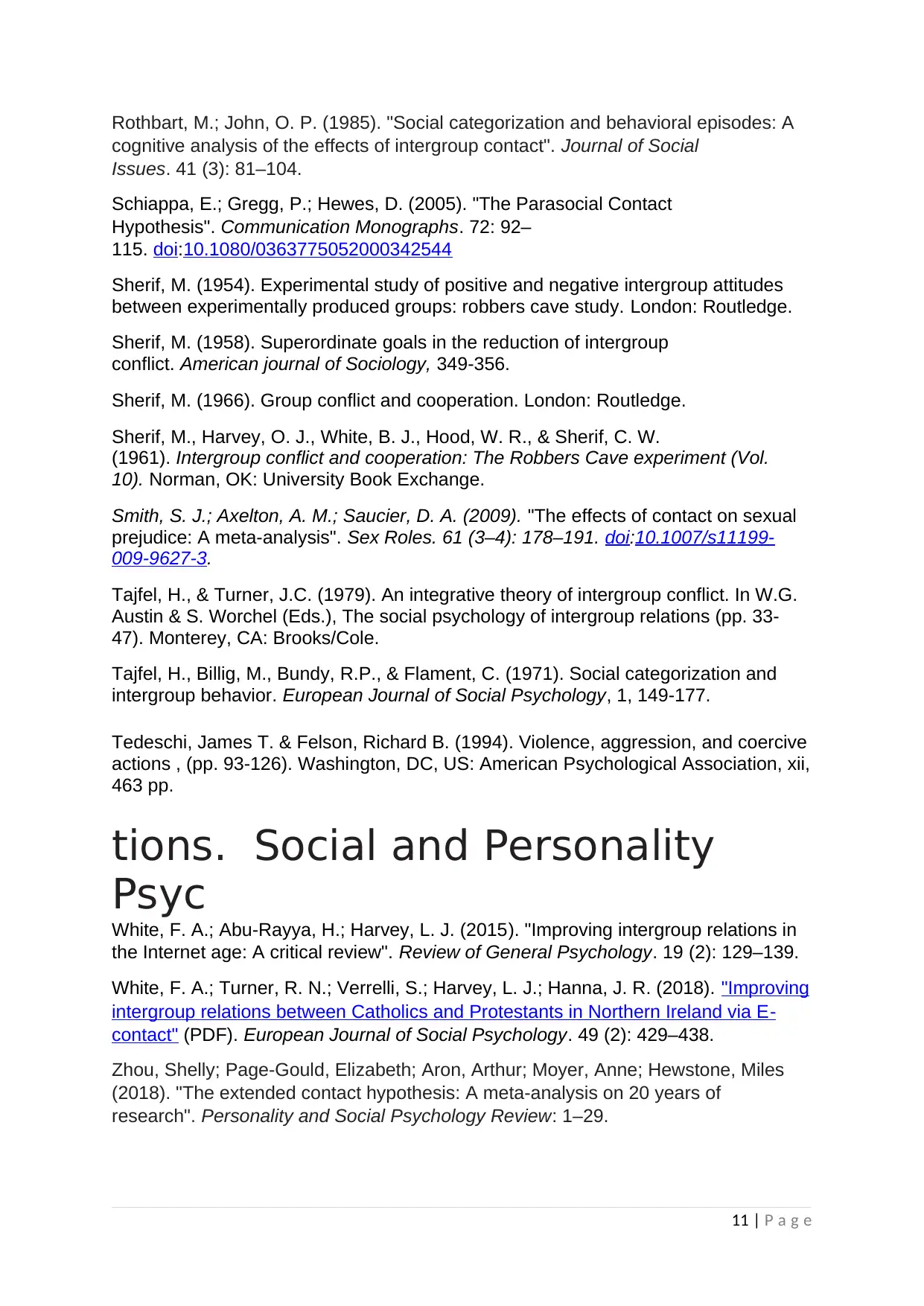
Rothbart, M.; John, O. P. (1985). "Social categorization and behavioral episodes: A
cognitive analysis of the effects of intergroup contact". Journal of Social
Issues. 41 (3): 81–104.
Schiappa, E.; Gregg, P.; Hewes, D. (2005). "The Parasocial Contact
Hypothesis". Communication Monographs. 72: 92–
115. doi:10.1080/0363775052000342544
Sherif, M. (1954). Experimental study of positive and negative intergroup attitudes
between experimentally produced groups: robbers cave study. London: Routledge.
Sherif, M. (1958). Superordinate goals in the reduction of intergroup
conflict. American journal of Sociology, 349-356.
Sherif, M. (1966). Group conflict and cooperation. London: Routledge.
Sherif, M., Harvey, O. J., White, B. J., Hood, W. R., & Sherif, C. W.
(1961). Intergroup conflict and cooperation: The Robbers Cave experiment (Vol.
10). Norman, OK: University Book Exchange.
Smith, S. J.; Axelton, A. M.; Saucier, D. A. (2009). "The effects of contact on sexual
prejudice: A meta-analysis". Sex Roles. 61 (3–4): 178–191. doi:10.1007/s11199-
009-9627-3.
Tajfel, H., & Turner, J.C. (1979). An integrative theory of intergroup conflict. In W.G.
Austin & S. Worchel (Eds.), The social psychology of intergroup relations (pp. 33-
47). Monterey, CA: Brooks/Cole.
Tajfel, H., Billig, M., Bundy, R.P., & Flament, C. (1971). Social categorization and
intergroup behavior. European Journal of Social Psychology, 1, 149-177.
Tedeschi, James T. & Felson, Richard B. (1994). Violence, aggression, and coercive
actions , (pp. 93-126). Washington, DC, US: American Psychological Association, xii,
463 pp.
tions. Social and Personality
Psyc
White, F. A.; Abu-Rayya, H.; Harvey, L. J. (2015). "Improving intergroup relations in
the Internet age: A critical review". Review of General Psychology. 19 (2): 129–139.
White, F. A.; Turner, R. N.; Verrelli, S.; Harvey, L. J.; Hanna, J. R. (2018). "Improving
intergroup relations between Catholics and Protestants in Northern Ireland via E‐
contact" (PDF). European Journal of Social Psychology. 49 (2): 429–438.
Zhou, Shelly; Page-Gould, Elizabeth; Aron, Arthur; Moyer, Anne; Hewstone, Miles
(2018). "The extended contact hypothesis: A meta-analysis on 20 years of
research". Personality and Social Psychology Review: 1–29.
11 | P a g e
cognitive analysis of the effects of intergroup contact". Journal of Social
Issues. 41 (3): 81–104.
Schiappa, E.; Gregg, P.; Hewes, D. (2005). "The Parasocial Contact
Hypothesis". Communication Monographs. 72: 92–
115. doi:10.1080/0363775052000342544
Sherif, M. (1954). Experimental study of positive and negative intergroup attitudes
between experimentally produced groups: robbers cave study. London: Routledge.
Sherif, M. (1958). Superordinate goals in the reduction of intergroup
conflict. American journal of Sociology, 349-356.
Sherif, M. (1966). Group conflict and cooperation. London: Routledge.
Sherif, M., Harvey, O. J., White, B. J., Hood, W. R., & Sherif, C. W.
(1961). Intergroup conflict and cooperation: The Robbers Cave experiment (Vol.
10). Norman, OK: University Book Exchange.
Smith, S. J.; Axelton, A. M.; Saucier, D. A. (2009). "The effects of contact on sexual
prejudice: A meta-analysis". Sex Roles. 61 (3–4): 178–191. doi:10.1007/s11199-
009-9627-3.
Tajfel, H., & Turner, J.C. (1979). An integrative theory of intergroup conflict. In W.G.
Austin & S. Worchel (Eds.), The social psychology of intergroup relations (pp. 33-
47). Monterey, CA: Brooks/Cole.
Tajfel, H., Billig, M., Bundy, R.P., & Flament, C. (1971). Social categorization and
intergroup behavior. European Journal of Social Psychology, 1, 149-177.
Tedeschi, James T. & Felson, Richard B. (1994). Violence, aggression, and coercive
actions , (pp. 93-126). Washington, DC, US: American Psychological Association, xii,
463 pp.
tions. Social and Personality
Psyc
White, F. A.; Abu-Rayya, H.; Harvey, L. J. (2015). "Improving intergroup relations in
the Internet age: A critical review". Review of General Psychology. 19 (2): 129–139.
White, F. A.; Turner, R. N.; Verrelli, S.; Harvey, L. J.; Hanna, J. R. (2018). "Improving
intergroup relations between Catholics and Protestants in Northern Ireland via E‐
contact" (PDF). European Journal of Social Psychology. 49 (2): 429–438.
Zhou, Shelly; Page-Gould, Elizabeth; Aron, Arthur; Moyer, Anne; Hewstone, Miles
(2018). "The extended contact hypothesis: A meta-analysis on 20 years of
research". Personality and Social Psychology Review: 1–29.
11 | P a g e
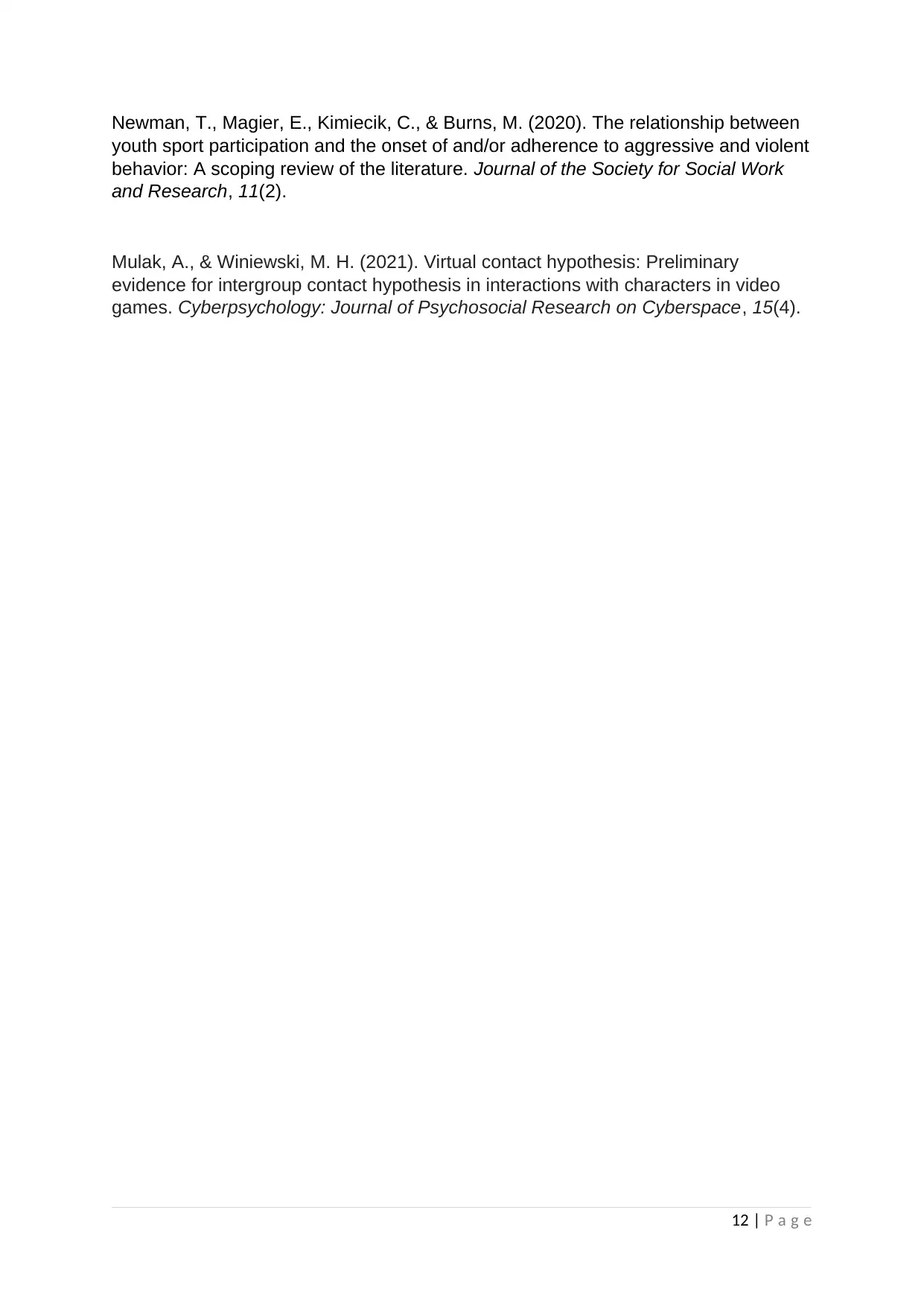
Newman, T., Magier, E., Kimiecik, C., & Burns, M. (2020). The relationship between
youth sport participation and the onset of and/or adherence to aggressive and violent
behavior: A scoping review of the literature. Journal of the Society for Social Work
and Research, 11(2).
Mulak, A., & Winiewski, M. H. (2021). Virtual contact hypothesis: Preliminary
evidence for intergroup contact hypothesis in interactions with characters in video
games. Cyberpsychology: Journal of Psychosocial Research on Cyberspace, 15(4).
12 | P a g e
youth sport participation and the onset of and/or adherence to aggressive and violent
behavior: A scoping review of the literature. Journal of the Society for Social Work
and Research, 11(2).
Mulak, A., & Winiewski, M. H. (2021). Virtual contact hypothesis: Preliminary
evidence for intergroup contact hypothesis in interactions with characters in video
games. Cyberpsychology: Journal of Psychosocial Research on Cyberspace, 15(4).
12 | P a g e
⊘ This is a preview!⊘
Do you want full access?
Subscribe today to unlock all pages.

Trusted by 1+ million students worldwide
1 out of 12
Related Documents
Your All-in-One AI-Powered Toolkit for Academic Success.
+13062052269
info@desklib.com
Available 24*7 on WhatsApp / Email
![[object Object]](/_next/static/media/star-bottom.7253800d.svg)
Unlock your academic potential
Copyright © 2020–2025 A2Z Services. All Rights Reserved. Developed and managed by ZUCOL.





